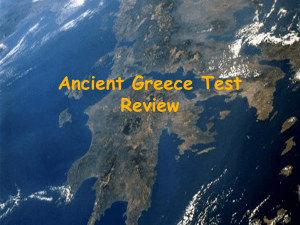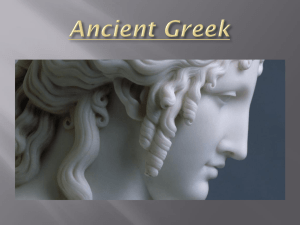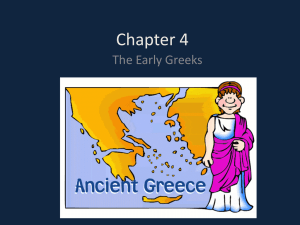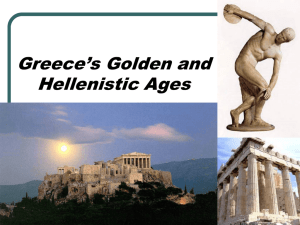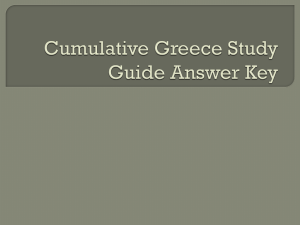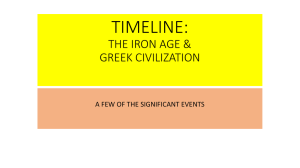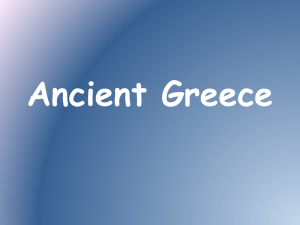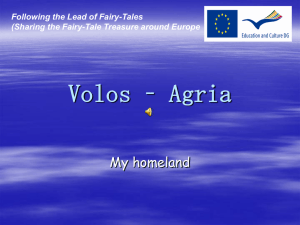Greece
advertisement
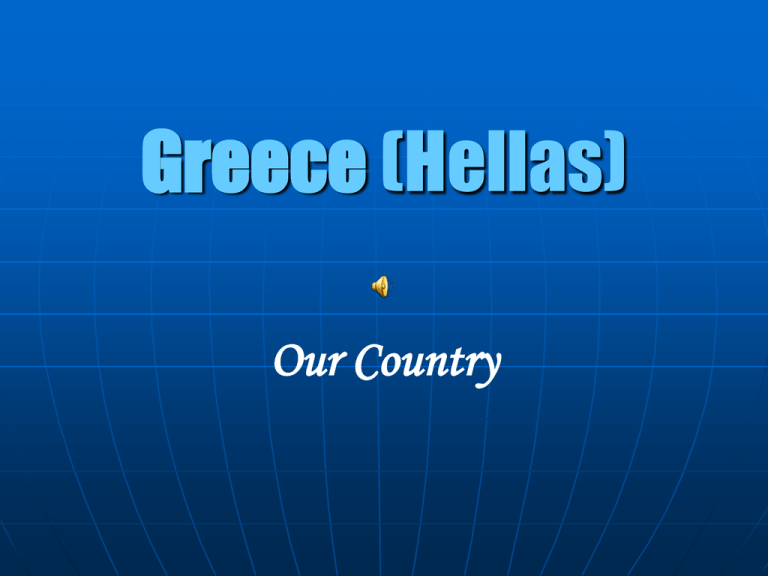
Greece (Hellas) Our Country Location of Greece Greece is a country of Europe. It is located in the South East Europe, part of the Balkan peninsula. Surface area–Population The total surface of Greece is 131.944 sqkm. The population of it is 10.964.020 people, according to the latest census of 2001. Ethnic Composition 797.091 people in Greece are foreigners who come from other Balkan countries or countries of East Europe, Africa and Asia. Religion The dominant religion in Greece, as indicated in the Greek Constitution, is the Eastern Orthodox Church of Christ. The Greeks are Orthodox Christians in 97% of the population. The remaining 3% are Muslims, Jews, Catholics (photo:The dome and bell tower of an orthodox church on the island of Santorini) Flag of Greece The flag of Greece is based on nine equal horizontal stripes of blue, alternative with white. There is a blue canton in the upper hoist side corner bearing a white cross. The cross symbolizes Greek Orthodoxy, the established religion of the people of Greece. According to the popular tradition the nine stripes represent the letters of the word “freedom” (Greek: Ελευθερία-Elefteria). There is also a different theory which says that the blue and white symbolizes the colours of the famed Greek sky and sea (combined with the white clouds and waves). The Greek Emblem The Emblem of Greek Democracy consists of a blue shield which forms a peak in the middle of the underside of it. In the middle of the shield bears a white cross, which is entirely surrounded by two laurel branches. Political System The political system in Greece is a parliamentary democracy. On top of the state is the President, the executive power is vested by the Government and the legislature is the Parliament (photo: The House of Parliament) Currency The Euro is the official currency of Greece which is a country member of the Euro zone. Drachma was replaced by Euro in 2002. All circulating coins have a common side for all the sixteen countries of E.C., showing the denomination or value and a map in back ground. The coins also have a national side showing an image specifically chosen by the country that issued the coin. Coins which have a small value present Greek ships while those of a bigger value present people of Greek history. The coin of 1 Euro presents the ancient Greek drachma. The coin of 2 Euro presents the abduction of Europa by Zeus in bull, according to Greek mythology. Horizontal and Vertical Unbundling About 80% of the territory of Greece is mountainous. The highest mountain is Mount Olympus (2.917m. height). (photo: Mount Olympus) The coastline of Greece (15.021 km) is equal to one fifth of the length of the coast of Europe. The Greece has 2.000 islands in the Aegean and Ionian Sea. 225 islands οf these are inhabited while the rest are rocky. (photo:Myrtos beach on the island of Kefalonia in the Ionian Sea) Climate The climate of Greece has all the characteristics of Mediterranean climate. It doesn’t rain much, it is quite dry during the summer months and the winters are quite mild, with long periods of sunshine throughout the year. Flora and Fauna Τhere are more than 6.000 plant species in Greece. 780 of these are found only in Greece. There are coniferous forests (pine and fir), areas with small bushes, olive groves, vineyards, fruit trees. There are over 1.200 types of animals in our country. In the mountains of our country you can see the wolf, the fox, the bear, the eagle, the hawk. In coastal areas there are sea gulls and a wide variety of fish. Near the lakes there are many rare species of pelicans. There is also a viper and the turtle and a lot of well-known domestic animals. Capital Athens is the capital and the largest city of Greece. In ancient Greek the name of Athens was related to the name of the goddess Athena who was its protector. Its population is almost one third of the total population of Greece and is, according to the census of 2001, 3.361.806 inhabitants. Our City Our city is Volos. Volos is located in Central Greece in Thessaly region and it is the capital of the prefecture of Magnesia. It has a population of 150.000 inhabitants and it is the most important port in the region. (photo: A view of the beach of Volos) Our school is located on the outskirts of Volos region. Agria is just 7 km away from the city of Volos, a town by the sea with 12.000 inhabitants. (photo: The Pagasitic Bay. In the background the town of Agria) Other Cities Thessaloniki is the second biggest city in Greece. Its population is 1.057.82 people. It is situated in the region of Macedonia. (photo:The beach of Thessaloniki and in the background, the White Tower) Patras is the third largest city of Greece with a population of more than 200.000 people. It is located in Peloponnesus and is the gateway to Europe as it is connected with Italy. (photo: View of Patras) Other Cities Chania is the second largest city of Crete island (80,000 inhabitants), but it is considered to be the most beautiful. Millions of visitors from all around the world have their holidays there each year. (photo: The lighthouse and the old Venetian port of Chania) Ioannina is an other big city. It is located in Epirus region. Its population is 70.203 people. It is famous for its lake. (photo: The lake of Ioannina) Occupations of habitants 12% of the working population in Greece are employed in the primary sector (agriculture, livestock, fishing). About 20% of the workforce are employed in the secondary sector (industry and crafts) and 68% are employed in the tertiary sector (employees). (Eurostat 2007) Unemployment in Greece exceeded 12.5% of the workforce last year. (National Statistical Service ) Historical Facts Neolithic settlements in Greece: Sesklo and Dimini in Magnesia (6800-3200 BC) (photo: Neolithic settlement in Dimini) The Bronze Age in Greece:Cycladic, Minoan, Mycenaean civilization, (3.000 1.100 BC) (photo:The Minoan Palace of Knossos on Crete) Historical Facts Median Wars: The Greek city-states repel Persian expansion into Europe. Battles of Marathon, Thermopylae, at Plataea, Seafight of Salamis (490-479 BC) Historical Facts The golden age of Athenian Democracy. Major monuments of art in the city of Athens (second half of the fifth century BC) (photo:monuments on the Acropolis Hill) Macedonians Dynasty. Alexander the Great defeats the Persians and spread Greek culture to Asia 334-323 BC). (photo:The battle of Issus between Greeks and Persians) Historical Facts 146 BC: The Romans conquered Greece. 330 AD: The capital of the Roman Empire was moved from Rome to Byzantium by Constantine the Great. The city was renamed Constantinople. (photo: Constantine the Great, Mosaic from the church of St. Sophia) 395 AD : The Roman Empire was divided into East and West. The first with its capital in Constantinople flourished for nearly 1100 years based on the Greek language and culture and Christian religion. (photo: The Church of St. Sophia in Constantinople) Historical Facts 29 May 1453: Constantinople and throughout the Byzantine Empire fell to the Ottoman Turks. (photo: Siege of Constantinople by the Ottoman Turks) The Greek Revolution against Ottoman Empire starts in March 1821. After nine years of war fighting and diplomacy the modern Greek state was founded. (photo: Th. Vrizakis “The exodus of Greeks besieged in Messonghi”) Historical Facts 1917-1918: Greece participates in the First World War on the side of the Entente. (photo: Victorious Greek army parade in Paris) 1940-1941: Greece rejects the Italian attack and enters the Second World War. Forcing Germany to intervene. (photo:A. Alexandrakis: “Greek invasion“) 1941-1944: Period of occupation by German, Italian and Voulgarian troops. Historical Facts 1947: With the addition of the Dodecanese Greek state reaches the current borders. (photo: Rodos, the capital of the region of Dodecanese) 1.1.1981: Greece becomes a full member of the EEC (Now EU) (photo: The signing of the Treaty of Accession to the EEC) Famous Persons in Greek History Miltiades was the leader of the Greeks against the Persians at the Battle of Marathon (490 BC). Genius Athenian politician and general. Leonidas was the leader of the Spartians. He was “sacrificed” at Thermopylae in 480 BC along with 300 soldiers in his effort not allow the Persian army to conquer Greece. Famous Persons in Greek History Pericles: Ancient Athenian politician. He laid the foundations for Athenian democracy of the 5th century BC. The monuments on the Acropolis were created in the period of his administration, called "Golden Age". Alexander the Great (356-323 BC): Macedonia leader and ruler of all the ancient Greek citystates. A student of the philosopher Aristotle (photo). With his military campaign in Asia he spread the Greek culture. Famous Persons in Greek History Theodoros Kolokotronis (1770-1843): He was commander of the Greek Revolution of 1821 and the most popular hero for today's Greeks. Ioannis Kapodistrias (1776-1831) was Foreign Minister in Russia at the time of the Greek Revolution of 1821. By his contribution to the diplomatic field he helped in the recognition of Greek independence in 1830. He was the first Governor of the modern Greek state. Famous Persons in Greek History Eleftherios Venizelos (1864-1936) was the politician who has renewed and modernized the political life of Greece in the early 20th century. Greece has multiplied in size and in population after the successes in the Balkan wars and the First World War in the years Eleftherios Venizelos was a Prime Minister. The Athens airport has his name. Constantine Karamanlis (1907-1998) His name was associated to the economic development of Greece after World War II and the restoration of democracy in 1974 after seven years of dictatorship. He was the initiator of the policy that led to the accession of Greece to EU. He was Prime Minister and President of the Republic for 24 years. Greetings Good morning = καλημέρα (kalimera) Good afternoon = καλησπέρα (kalispera) Good night = καληνύχτα (kalinihta) Hello = Γεια σας (gia sas) How are you? = Πώς είσαι; (pos ise) Good bye = Αντίο (adio) Hi = Γεια (gia) Landscape that I love Santorini (Thira) is a volcanic island in the Aegean Sea. It is created from pieces of lava emerged from the sea and land tracks of a prehistoric island, which were not sunk after a terrible earthquake. …Oh daughter of a top anger. Nude, rising from the sea. Open the brilliant gates of a man, the place to be scented with health. In thousands of colors to sprout again feeling knocking off the wings. And blow the freedom from everywhere… "Ode to Santorini" Odysseus Elytis - Nobel Prize for Literature (1979) Proverbs Love your friend with his foibles. (A tip for everlasting friendship) A lazy youth, when old, a beggar. (The importance of hard work) Listen to all, say little. (The ancient Greeks claimed that talking a little is a sample of the philosopher) Poem “ Tell me, O Muse, of the man of many devices, who wandered full many ways after he had sacked the sacred citadel of Troy. Many were the men whose cities he saw and whose mind he learned, aye, and many the woes he suffered in his heart upon the sea, seeking to win his own life and the return of his comrades. Yet even so he saved not his comrades, though he desired it sore, for through their own blind folly they perished—fools, who devoured the kine of Helios Hyperion; but he took from them the day of their returning. […]” Homer's "Odyssey" Poem Homer (photo) is the ancient Greek (8th century BC) epic poet, author of the epic poems the Iliad and the Odyssey, the Homeric Hymns. Homer's epics stand at the beginning of the western canon of literature, exerting enormous influence on the history of fiction and literature in general. “Odyssey”: The poem mainly centers on the Greek hero Odysseus and his long journey home following the fall of Troy. It takes Odysseus ten years to reach Ithaca after the ten-year Trojan War. In his absence, it is assumed he has died, and his wife Penelope and son Telemachus must deal with a group of unruly suitors, the Mnesteres competing for Penelope's hand in marriage. Famous Painter El Greco (1541-1614) was a painter, sculptor and architect. El Greco was a nickname, a reference to his Greek origin. His full name was Domenikos Theotokopoulos. He was born in Crete. At the age 26 he travelled to Italy, where he enriched his style in painting with elements of Mannerism and of Renaissance. In 1577 he moved to Toledo, Spain, where he lived and worked until his death. He is best known for tortuously elongated figures and fantastic pigmentation. (photo: “The Adoration of the Shepherds”) Recipe Fasolada (φασολάδα)/ Bean soupe: Plate of traditional Greek cuisine. It is a soup made after cooking the following material in a saucepan: dry beans, carrot, celery, parsley, onion, olive oil and tomato paste. Traditional sausage and red pepper can be also added. It was the national food of the Greeks in the years of rural economy. Each family could produce those materials so, it could feed a sufficient number of people in a hygenic manner. Sports Football and basketball are the most popular sports in Greece. There are thousands of clubs and millions of people engaged in a business or hobby with them. In football the greatest success was the winning of the European Championship in 2004 by our National Team (photo). In basketball there are successes in national and club level. The national team was European champion in 1987, 2005 (photo) and second in the World Championship in 2006. Panathinaikos, a famous Greek club, is five times European champion in last fourteen years. Famous Greeks Maria Callas (1923-1977) was a famous singer. She was a soprano and the most famous opera diva. Aristotle Onassis (1900-1975) was one of the richest people in the world. His involvement with the companies made him famous as well as his personal life. Callas and Onassis were a couple for many years (photo). Dr George Papanicolaou (18831962) was a Greek pioneer in cytology and early cancer detection, and the inventor of the “Pap smear". Millions of women around the world owe their salvation from cervical cancer in his own scientific methods and discoveries (photo). Famous Monument Parthenon is probably the most famous and most visited monument in the world from the Antiquity times. Is the symbol of the Ancient Greek civilization. It was built on the rock of Acropolis, where there are several monuments from the Golden Era of Athens. The temple of Parthenon was dedicated to Goddess Athena, protector of the ancient city of Athens. It was built under Pericles administration by the architects Iktinos and Kalikrates. There was a magnificent statue of Goddess Athena inside it, made by Phidias, inside. The external pillars of the Parthenon are not exactly straight, they are slightly curved so they give an optical illusion as if they were straight for every ankle you will look. The “International” Greek Language “Pause, telephone, enthusiasm, dialogue, call, method, episode, organization, economic, idea, synthesize, problem, melancholy, phenomenon, characteristic, epoch, program, practice, chaos, parallel, climate, basic, apologize, ironic, strategic, magic, butter, paper, scheme, pirate, channel, devil, diplomat, anemia, oxygen, peptic, stomach, symptom, organ, biology, gastronomic, magnet, pole, electronic, algebra, geometry, mathematics, archeology, astronomy, geography, pedagogical, political, democracy, anarchy, philosophy, orthodoxy, catholic, …” Only a few examples from the traces of Greek culture and Greek language in the world community. Not only words that come from Greece, but also a whole world of ideas and science with Greek roots. We can be proud for all these ... The music of the presentation comes from the Greek composer Stamatis Spanoudakis and it has the title “Sea”. The students of E class who cooperated for the presentation of the country are: Stefanos Akrivogiannis, Maria Vlahou, Matoula Gerovasili, Laura Giakou, Liana Diavitidi, Katerina Zafiriou, Elisabeth Theohari, Paris Kalafatakis, Kalie Kafasi, Thanasis Kostanasios, Georgia Makri, Rosalinda Moutso, Phanis Moutso, Donald Skouka, Anna Tselikou, Alkis Tsetsilas with the help of the teachers of our school: Tenia Goutzoulia, Sophia Vasiliou, Xanthoula Danilopoulou.
